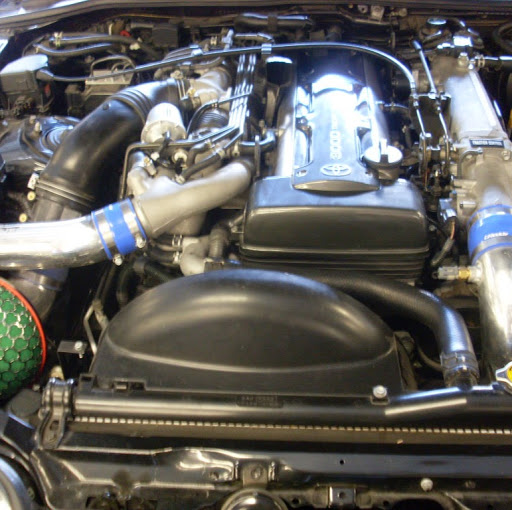Joseph A Tate
age ~63
from San Jose, CA
- Also known as:
-
- Joe A Tate
- Joseph A Florez
- Joea Tate
- Josepha Tate
- Phone and address:
- 349 Saint James St, San Jose, CA 95112
Joseph Tate Phones & Addresses
- 349 Saint James St, San Jose, CA 95112
- 184 S 13Th St, San Jose, CA 95112 • 4082933438
- 1265 Tofts Dr, San Jose, CA 95131
- Hayward, CA
Isbn (Books And Publications)


Medicine Doctors

Joseph L. Tate
view sourceSpecialties:
Obstetrics & Gynecology
Work:
Dekalb-Gwinnett Obstetrics & Gynecology PC
4045 Wetherburn Way STE 4, Norcross, GA 30092
7704498171 (phone), 7704495015 (fax)
4045 Wetherburn Way STE 4, Norcross, GA 30092
7704498171 (phone), 7704495015 (fax)
Education:
Medical School
Yale University School of Medicine
Graduated: 1980
Yale University School of Medicine
Graduated: 1980
Procedures:
Amniocentesis
Cesarean Section (C-Section)
D & C Dilation and Curettage
Delivery After Previous Caesarean Section
Ovarian Surgery
Tubal Surgery
Vaccine Administration
Vaginal Delivery
Cesarean Section (C-Section)
D & C Dilation and Curettage
Delivery After Previous Caesarean Section
Ovarian Surgery
Tubal Surgery
Vaccine Administration
Vaginal Delivery
Conditions:
Abnormal Vaginal Bleeding
Breast Disorders
Candidiasis of Vulva and Vagina
Complicating Pregnancy or Childbirth
Conditions of Pregnancy and Delivery
Breast Disorders
Candidiasis of Vulva and Vagina
Complicating Pregnancy or Childbirth
Conditions of Pregnancy and Delivery
Languages:
English
Spanish
Spanish
Description:
Dr. Tate graduated from the Yale University School of Medicine in 1980. He works in Norcross, GA and specializes in Obstetrics & Gynecology. Dr. Tate is affiliated with Emory University Hospital Midtown.

Joseph P. Tate
view sourceSpecialties:
Family Medicine
Work:
Heritage Victor Valley Medical GroupFamily Practice Associates
11919 Hesperia Rd STE A, Hesperia, CA 92345
7609481454 (phone), 7609486100 (fax)
Richard A Baumgartner MD
42002 Foxfarm Rd STE 200, Big Bear, CA 92315
9098665808 (phone), 9098669502 (fax)
11919 Hesperia Rd STE A, Hesperia, CA 92345
7609481454 (phone), 7609486100 (fax)
Richard A Baumgartner MD
42002 Foxfarm Rd STE 200, Big Bear, CA 92315
9098665808 (phone), 9098669502 (fax)
Languages:
English
Spanish
Spanish
Description:
Mr. Tate works in Big Bear Lake, CA and 1 other location and specializes in Family Medicine. Mr. Tate is affiliated with St Bernardine Medical Center and Victor Valley Global Medical Center.
Us Patents
-
Camera Integrated Into A Display
view source -
US Patent:20210271290, Sep 2, 2021
-
Filed:May 17, 2021
-
Appl. No.:17/322689
-
Inventors:- Palo Alto CA, US
Xinrui JIANG - San Jose CA, US
Andrew E. RUBIN - Los Altos CA, US
Matthew HERSHENSON - Los Altos CA, US
Xiaoyu MIAO - Palo Alto CA, US
Joseph Anthony Tate - San Jose CA, US -
International Classification:G06F 1/16
H04N 5/225
G02F 1/1333
G02F 1/1335
G02F 1/1368 -
Abstract:Certain aspects of the technology disclosed herein integrate a camera with an electronic display. An electronic display includes several layers, such as a cover layer, a color filter layer, a display layer including light emitting diodes or organic light emitting diodes, a thin film transistor layer, etc. The camera can include a plurality of noncontiguous pixel regions disposed beneath the display layer and be configured to capture a plurality of images corresponding to the plurality of noncontiguous pixel regions. In some embodiments, the plurality of images can form a composite image with depth.
-
Sensing Light Through A Surface With A Residue
view source -
US Patent:20180350090, Dec 6, 2018
-
Filed:Nov 22, 2017
-
Appl. No.:15/821047
-
Inventors:- Palo Alto CA, US
Xinrui Jiang - San Jose CA, US
Andrew E. Rubin - Los Altos CA, US
Matthew Hershenson - Los Altos CA, US
Xiaoyu Miao - Palo Alto CA, US
Joseph Anthony Tate - San Jose CA, US -
International Classification:G06N 99/00
G01N 21/01 -
Abstract:In one embodiment, a light sensor, such as a camera, records an image through the surface with the residue to produce a stained image. A processor associated with the camera identifies object outlines within the image using a machine learning model, and smooth the colors within the object outlines. In another embodiment, the light sensor is placed beneath a dual-mode region of a display containing the residue. The dual-mode region can be opaque and function as part of the display, or can be transparent and allow environment light to reach the light sensor. Initially, the processor determines the position of the residue by causing the dual-mode region to display a predetermined pattern, while the light sensor records the predetermined pattern. Using the determined position of the residue, the processor corrects the pixels within the residue in the recorded image, by interpolating the values of the pixels outside of the residue.
-
Passive Heat Transport Subsystems In Handheld Electronic Devices
view source -
US Patent:20180317339, Nov 1, 2018
-
Filed:Oct 6, 2017
-
Appl. No.:15/727507
-
Inventors:- Palo Alto CA, US
William Francis Leggett - San Jose CA, US
Joseph Anthony Tate - San Jose CA, US -
International Classification:H05K 7/20
-
Abstract:A handheld electronic device including a plurality of electronic components and a channel forming a cavity extending continuously across the handheld electronic device to enable an airflow through the handheld electronic device to an external environment. The handheld electronic device includes an inlet of the channel cavity configured to accept air from the external environment and an outlet of the channel cavity configured to expel heated air to the external environment when the handheld electronic device is oriented such that the airflow moves by natural convection from the inlet toward the outlet.
-
Camera Integrated Into A Display
view source -
US Patent:20180107241, Apr 19, 2018
-
Filed:Nov 22, 2017
-
Appl. No.:15/820954
-
Inventors:- Palo Alto CA, US
Xinrui Jiang - San Jose CA, US
Andrew E. Rubin - Los Altos CA, US
Matthew Hershenson - Los Altos CA, US
Xiaoyu Miao - Palo Alto CA, US
Joseph Anthony Tate - San Jose CA, US -
International Classification:G06F 1/16
H04N 5/33
G02F 1/1333
H04N 5/225
H01L 51/56
H01L 51/52
H01L 27/32
H01L 27/146
G06F 3/041
G02F 1/1368
G02F 1/1335 -
Abstract:Certain aspects of the technology disclosed herein integrate a camera with an electronic display. An electronic display includes several layers, such as a cover layer, a color filter layer, a display layer including light emitting diodes or organic light emitting diodes, a thin film transistor layer, etc. In one embodiment, the layers include a substantially transparent region disposed above the camera. The substantially transparent region allows light from outside to reach the camera, enabling the camera to record an image. In another embodiment, the color filter layer does not include a substantially transparent region, and the camera records the light from the outside colored by the color filter layer. According to another embodiment, while none of the layers include a substantially transparent region, the layers are all substantially transparent, and the camera disposed beneath the layers records light reaching the camera from outside.
-
Systems And Techniques For Intelligently Switching Between Multiple Sources Of Universal Serial Bus Signals
view source -
US Patent:20180095922, Apr 5, 2018
-
Filed:Dec 6, 2017
-
Appl. No.:15/833830
-
Inventors:- Palo Alto CA, US
Andrew E. Rubin - Los Altos CA, US
David John Evans, V - Palo Alto CA, US
Matthew Hershenson - Los Altos CA, US
Xiaoyu Miao - Palo Alto CA, US
Xinrui Jiang - San Jose CA, US
Joseph Anthony Tate - San Jose CA, US -
International Classification:G06F 13/40
G06F 3/041
H04M 1/02
G06F 13/42 -
Abstract:Various embodiments concern techniques for intelligently switching between multiple sources of USB signals. More specifically, user devices are described that include a physical USB port for receiving a USB connector and one or more wireless transceivers that communicate with an accessory. The wireless transceiver(s) may communicate with the accessory using a USB-based protocol (e.g., Wireless USB). The user devices described herein can intelligently switch between these different sources of USB signals so that USB signals can be simultaneously or sequentially received from a peripheral (via the USB port) and an accessory (via the wireless transceiver(s)). In some embodiments, a switching routine is executed (e.g., by a processor or signal switch) that determines which peripheral and/or accessory is connected to a user device at a given point in time.
-
Hollowed Electronic Display
view source -
US Patent:20180097022, Apr 5, 2018
-
Filed:Dec 5, 2017
-
Appl. No.:15/832079
-
Inventors:- Palo Alto CA, US
Xinrui Jiang - San Jose CA, US
Andrew E. Rubin - Los Altos CA, US
Matthew Hershenson - Los Altos CA, US
Xiaoyu Miao - Palo Alto CA, US
Joseph Anthony Tate - San Jose CA, US
Rebecca Schultz Zavin - Portola Valley CA, US -
International Classification:H01L 27/12
G02F 1/1362
G02F 1/133
G02B 5/30
F21V 8/00
G02B 26/08
G02B 5/20
G02F 1/1339
G02F 1/1335
G02F 1/1341
G02F 1/1343
G02F 1/1368
G02F 1/1333 -
Abstract:Presented here are manufacturing techniques to create an irregularly shaped electronic display, including a hollow within which a sensor, such as a camera, can be placed. The manufacturing techniques enable the creation of the hollow anytime during the manufacturing process. The resulting electronic display occupies the full side of the mobile device, with the sensors placed within and surrounded by the display.
-
Ambient Light Sensor
view source -
US Patent:20180080820, Mar 22, 2018
-
Filed:Nov 29, 2017
-
Appl. No.:15/825557
-
Inventors:- Palo Alto CA, US
Xinrui Jiang - San Jose CA, US
Andrew E. Rubin - Los Altos CA, US
Matthew Hershenson - Los Altos CA, US
Xiaoyu Miao - Palo Alto CA, US
Joseph Anthony Tate - San Jose CA, US
Rebecca Schultz Zavin - Portola Valley CA, US -
International Classification:G01J 1/44
G01J 1/04 -
Abstract:Presented here are devices and methods to correct ambient light measurements made in the presence of optical elements, such as the curved edge of the cover glass associated with the mobile device. In one embodiment, a film with optical properties is placed within the ambient light sensor to diffuse the high-intensity light beam coming from the optical element. In another embodiment, an aperture associated with the ambient light sensor is disposed to prevent the high-intensity light beam from entering the ambient light sensor. In another embodiment, a processor coupled to the ambient light sensor smooths the peak associated with the high intensity light beam produced by the optical element.
-
Electronic Display With A Relief
view source -
US Patent:20180074586, Mar 15, 2018
-
Filed:May 2, 2017
-
Appl. No.:15/585146
-
Inventors:- Palo Alto CA, US
Andrew E. Rubin - Los Altos CA, US
Xinrui Jiang - San Jose CA, US
Xiaoyu Miao - Palo Alto CA, US
Joseph Anthony Tate - San Jose CA, US
Matthew Hershenson - Los Altos CA, US
Michael Kolb - Redwood City CA, US -
International Classification:G06F 3/01
H04N 1/00
G06F 3/041 -
Abstract:Introduced here are methods and systems to create a relief on an electronic display. In one embodiment, the relief is created by micro-electromechanical systems (MEMS) placed above a cover layer of the electronic display. Each MEMS when activated can protrude or depress, thus creating the relief on the electronic display. In another embodiment, the relief is created by a plurality of resistors placed beneath the cover layer. The cover layer is made out of an elastically deformable material that, when heated, expands, thus creating a protrusion on the electronic display. Each resistor when activated heats a section of the cover layer, causing the cover layer to protrude.
Wikipedia References

Joseph Tate
Work:
Position:
Attorney • Justice
Education:
Studied at:
Curtis Institute of Music
Skills & Activities:
Preference:
White collar crime
Resumes

Joseph Tate
view source
Joseph Tate
view source
Joseph Tate
view source
Joseph Tate
view source
Joseph Tate
view sourceEducation:
High School
Skills:
Property Claims
Microsoft Word
Microsoft Office
Microsoft Excel
Estimating
English
Customer Service
Claims Handling
Claim Investigation
Microsoft Word
Microsoft Office
Microsoft Excel
Estimating
English
Customer Service
Claims Handling
Claim Investigation

Joseph Tate
view sourceLocation:
United States
Name / Title
Company / Classification
Phones & Addresses
TEST PROPERTIES LLC
TOTAL ENERGY SYSTEMS TECHNOLOGY, INC
Lawyers & Attorneys

Joseph Anthony Tate, San Jose CA - Lawyer
view sourceAddress:
184 S 13 Th St, San Jose, CA 95112
4082933438 (Office)
4082933438 (Office)
Licenses:
California - Active 1994
Education:
Worcester Polytechnic Institute
Santa Clara University School of Law
Santa Clara University School of Law

Joseph Tate - Lawyer
view sourceOffice:
Dechert LLP
Specialties:
Construction & Development
Business
Commercial
Securities Enforcement
White Collar and Securities Litigation
Business
Commercial
Securities Enforcement
White Collar and Securities Litigation
ISLN:
912205715
Admitted:
1996
University:
Boston University, B.A., 1990
Law School:
Villanova University School of Law, J.D., 1995
License Records
Joseph Euzebe Tate
License #:
EI.0021055 - Expired
Category:
Civil Engineer
Issued Date:
Jun 24, 2003
Expiration Date:
Mar 31, 2012
Flickr
Plaxo

Joseph Tate
view sourceSeattle, WAAfter finishing a Ph.D. on Shakespeare in 2005 and publishing a book the same year on Radiohead, I made the full-time transition in 2006 from university-level... After finishing a Ph.D. on Shakespeare in 2005 and publishing a book the same year on Radiohead, I made the full-time transition in 2006 from university-level teaching of literature (Ancient to Postmodern) and composition (expository, research and business writing) to web design and development. I...
Myspace
Youtube

Joseph Tate
view source
Joseph Tate
view source
Joseph Tate
view source
Joseph Tate
view source
Joseph Tate
view source
Joseph Tate
view source
Mark Joseph Tate
view source
Justin Joseph Tate
view sourceClassmates

Joseph Tate
view sourceSchools:
George Washington High School Danville VA 1949-1953

Joseph Tate
view sourceSchools:
Eastside High School Taylors SC 1985-1989
Community:
Robert Kinder, Vint Hargrave

Joseph Tate
view sourceSchools:
Edward Devotion Elementary School Brookline MA 1949-1954, Michael Driscoll Elementary School Brookline MA 1954-1957

Joseph Tate
view sourceSchools:
Clinchco High School Clinchco VA 1951-1955
Community:
James Sutherland, Kay Farmer

Joseph Tate III
view sourceSchools:
Walker High School Atlanta GA 1982-1986
Community:
Jami Paceleo, Glenda Harmon

Joseph Tate
view sourceSchools:
O'Fallon Technical High School St. Louis MO 1977-1981
Community:
Lena Sinclair, Carla Harbor, Kevin Blake, Kenneth Holmes, Ebeth Ewing

Joseph Tate
view sourceSchools:
Walker High School Walker LA 1976-1980
Community:
Kevin Hoover, Ami Wells, Lisha Ezell, Donna Martin, Donna Deville, Gina Crotwell, Renee Rochester, Brigitte Thompson, Nancy Caraway

Joseph Tate
view sourceSchools:
Sheepshead Bay.HS Brooklyn NY 1976-1980
Community:
Steven Kidan, Ronni Fuchs, Eric Schechter
Googleplus

Joseph Tate

Joseph Tate

Joseph Tate

Joseph Tate

Joseph Tate

Joseph Tate

Joseph Tate

Joseph Tate
Get Report for Joseph A Tate from San Jose, CA, age ~63
















